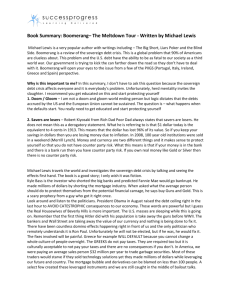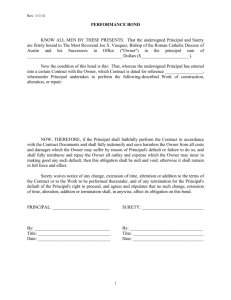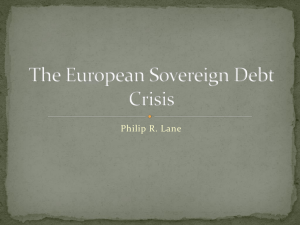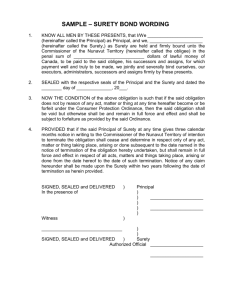Credit-Insurance - BIIA.com | Business Information Industry
advertisement
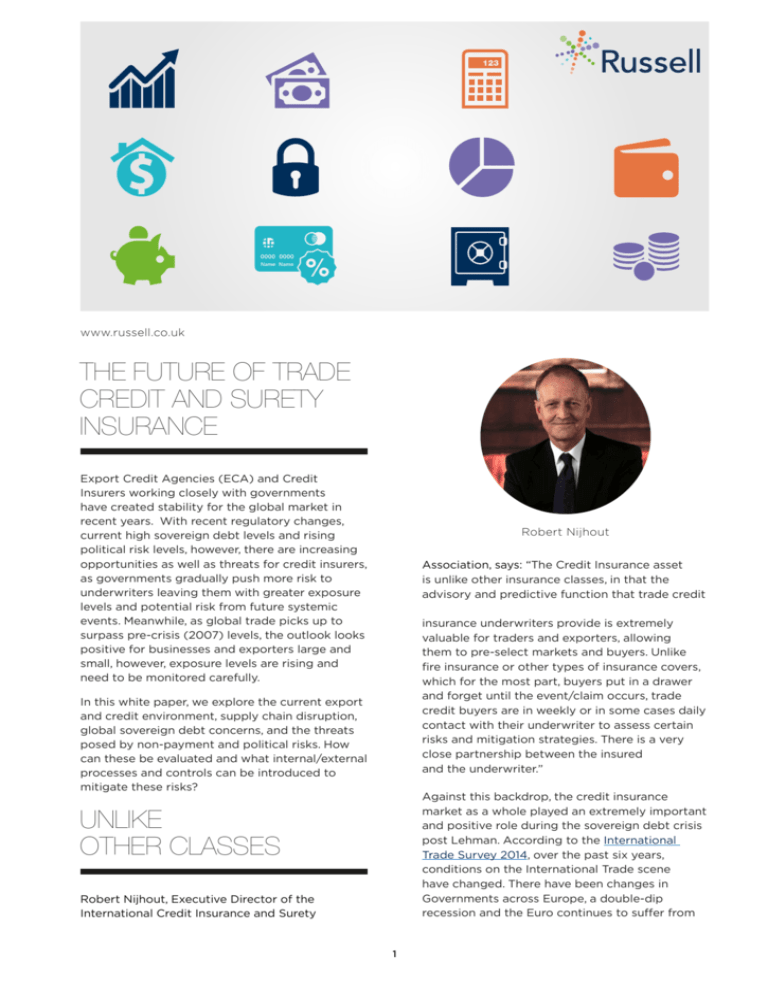
www.russell.co.uk THE FUTURE OF TRADE CREDIT AND SURETY INSURANCE Export Credit Agencies (ECA) and Credit Insurers working closely with governments have created stability for the global market in recent years. With recent regulatory changes, current high sovereign debt levels and rising political risk levels, however, there are increasing opportunities as well as threats for credit insurers, as governments gradually push more risk to underwriters leaving them with greater exposure levels and potential risk from future systemic events. Meanwhile, as global trade picks up to surpass pre-crisis (2007) levels, the outlook looks positive for businesses and exporters large and small, however, exposure levels are rising and need to be monitored carefully. Robert Nijhout Association, says: “The Credit Insurance asset is unlike other insurance classes, in that the advisory and predictive function that trade credit insurance underwriters provide is extremely valuable for traders and exporters, allowing them to pre-select markets and buyers. Unlike fire insurance or other types of insurance covers, which for the most part, buyers put in a drawer and forget until the event/claim occurs, trade credit buyers are in weekly or in some cases daily contact with their underwriter to assess certain risks and mitigation strategies. There is a very close partnership between the insured and the underwriter.” In this white paper, we explore the current export and credit environment, supply chain disruption, global sovereign debt concerns, and the threats posed by non-payment and political risks. How can these be evaluated and what internal/external processes and controls can be introduced to mitigate these risks? Against this backdrop, the credit insurance market as a whole played an extremely important and positive role during the sovereign debt crisis post Lehman. According to the International Trade Survey 2014, over the past six years, conditions on the International Trade scene have changed. There have been changes in Governments across Europe, a double-dip recession and the Euro continues to suffer from UNLIKE OTHER CLASSES Robert Nijhout, Executive Director of the International Credit Insurance and Surety 1 NEVER WRITE-OFF CREDIT INSURANCE volatility. There has been pressure on the financial markets caused by Greece, Ireland, Portugal and Spain, which have included economic bailouts by the IMF and European Central Bank. THE CREDIT INSURANCE SOLUTION The International Trade Survey 2014 reports that €360bn of debt has been written off in Europe due to late or non-payment of bills. Exporters therefore need to be more aware of these risks and how they can be mitigated. If the UK Government’s objective of doubling the level of exports by 2020 is to be realised, as part of the Coalition’s targets of £1 trillion of exports by 2020 - understanding what influences companies in the UK to export is an essential step towards achieving that goal. Since then, “Credit to small and medium-sized enterprises is being choked off by capital-short banks, particularly in the southern countries, according to a report in the Financial Times.” The FT reports that: “The problem is that neither the European Single Resolution Mechanism nor the Basel III process for de-risking the banking system are providing any incentive to increase the provision of credit to European SMEs”. The solution: turn to credit insurance, which businesses are doing in increasing numbers. Fear of non-payment for goods and services supplied to overseas clients is the most common risk cited by the Survey’s respondents. This arises because exporters believe that they would stand little chance of pursuing clients successfully through foreign courts. According to a press release note issued on the 10th June by the International Credit Insurance and Surety Association: “Insured exposure increased to a record 2 trillion Euro, which is confirmation of the improved outlook for trade and continuous support of trade credit insurers to their clients. Comparing the current environment with the pre-crisis (2007) period, ICISA indicates that its members’ results exceed pre-crisis levels, with a 31% higher premium income and 15% higher insured exposure.” In terms of the Surety market, ICISA says, “Comparing the 2013 Surety results with those from before the crisis (2007), premium income has more than doubled, while the insured exposure grew by more than 45%. THE DANGERS OF SOVEREIGN DEBT LEVELS If that were not enough, we are not out of the woods yet when it comes to sovereign debt risks. Robert Nijhout comments: “Credit insurers remain concerned about the levels of debt that countries retain because the sector regards countries first of all as debtors - government entities or very often semi-government entities are buyers of credit insurance - and very often their ability to pay or pay on time is very often strongly influenced by their debt levels and subsequent austerity measures that take place – or not as the case may be. “Sovereign debt levels and political risks are monitored daily and although credit insurers are risk takers per definition, seeking to assume as much risk as possible, there are clear limits and countries such as Iraq, Afghanistan, and Syria, where no sane person would underwrite credit for obvious reasons.” Much further down the risk register there are challenging markets - Argentina, Venezuela, Turkey and other markets where there are political tensions – and where the credit insurance community underwrites as much as it can. In such an environment, measurable levels of sovereign debt plays a crucial role in risk assessment 2 because the higher that, is the more difficult it will be for a government to comply with its debt obligations. things are usually done out of a political motive and not because the Government might go bankrupt. According to Nijhout: “The other side of the coin is that if you look at the European Union during the peak of the financial crisis, credit insurers and governments worked closely together in several member states to continue offering cover on certain risks when these risks became unattractive for private companies to underwrite. The trading community decided that it was in the interests of all to retain cover on a small percentage book of buyers, which is where governments intervened as the reinsurer to guarantee these risks instead of the commercial insurance market. GLOBAL DISRUPTION Where there is a will there is usually a way whether it is through austerity measures, large infrastructure projects or so-called quantitative easing stimulus packages. The scary thing that keeps credit insurers up at night, however, is supposing the government represents a polarised/divided electorate or different factions within a one party system. The politics of enmity and factionalism that in the past might have had largely internal knock-on consequences can lead to disruption on a global scale in today’s connected global system. POLITICAL RISKS ON THE RISE While infrastructure developments in the west have largely ground to a halt in recent years, demand is now slowly picking up but this opportunity is coupled with the threat of sovereign debt, the ability (or lack of therein) of governments to procure and invest or the risk of expropriation or restrictive regulation and legislation. A good example is Brazil where the economic boom that had been anticipated has yet to fully materialise due in large part to national legislation that prevented free open markets from functioning. There were other risk mitigation structures in place at the time, depending on the individual country but it helped in the depths of the crisis to reassure the market that there would be continuity. The fear is, however, that if the world enters a similar crisis along the lines experienced four or five years ago, taking into account current levels of sovereign debt, credit insurance analysts wonder to what extent governments would still be able to provide such levels of support. In short, the sovereign debt levels in many countries remain far too high and need to fall to a more historically acceptable level. ONE DOOR CLOSES BUT A NEW DOOR OPENS Nijhout says; “Political risks are on the rise, which is interesting because if you had polled anyone in the insurance sector six or seven years about this specialty insurance class the prevailing view would have been that this kind of cover had largely had its day. What we see now for political risk cover is that there is an increase in demand not just in so-called high risk markets in Africa or in Asia but more so in markets that would never have been regarded as a political risk, at least not in recent memory. Whether that is Greece or even France or the US and other Advanced Economies, take up of policies has become attractive for some insurance buyers to cover the political element that a government just doesn’t pay.” The flip side of that is there is great potential for previously closed markets to open for the first time in decades, the US crude oil export sector being a prime case in point. The US government could add more than US$1tn to its revenues if it reverses a 40-year-old ban on oil exports, a new report has claimed. IHS Global Insight’s report also claims that a reversal of the ban would also trim fuel prices, add an average of more than 300,000 jobs a year, and stimulate the economy. In the report, US Crude Oil Export Decision Assessing the Impact of the Export Ban and Free Trade on the US Economy, IHS states that if the ban was lifted the potential cumulative government revenue, in the period 2016 to 2030, could be US$1.3tn. The reality is of course that the vast majority of governments can always pay but following the recent stand-off between US Democrats and Republicans the perception has grown that a government will not pay. That is usually for a political reason whether it is through a currency default or devaluation or a haircut but these US exports of crude oil have been banned since 1975 as part of a law enforced by Congress in the 3 DEMAND-SIDE RISKS aftermath of the 1973 OPEC oil embargo to guard domestic reserves and protect US energy security. According to an IMF White Paper this year Tracking Global Demand for Emerging Market Sovereign Debt, Serkan Arslanalp and Takahiro Tsuda, March 2014, “Rising foreign participation in EM debt markets creates new opportunities but also new risks (“demand-side risks”). In particular, rising foreign participation in government debt markets can help reduce borrowing costs and spread risks more broadly among investors, but it can also raise external funding risks for the government. The world oil market is an entirely different animal today and has changed since the 1970s-era policy banning oil exports was initially introduced. IHS reports that there is a mismatch between the rapid growth of shale oil and the inability of the US refining system to economically process these growing volumes. At the same time we are seeing infrastructure projects in the US that are becoming so large that it becomes very hard for a single surety to supply a high percentage bond. In the US you see surety bonds with 90% limit of guaranty in the event of the default of the Principal, which means that in some mega-project cases you have to look at some kind of risk sharing or other structures because the risk becomes too large for any single surety company to absorb. According to the white paper: “These demandside risks make it important to track the investor base for government debt, especially from an international perspective. Having a crosscountry view of the sovereign investor base is essential for understanding global demand dynamics as changes in the country allocations of international investors affect many countries at once. Also, only internationally comparable data allow us to aggregate investor flows across countries to examine changes in the asset allocation of international investors.” RISE OF THE MEGA PROJECT The white paper also points out that during the Euro area debt crisis, domestic banks in a number of countries became significant buyers of government debt when foreign investors fled the market. Specifically, market concerns about sovereign risk could undermine confidence in banks and thus threaten domestic financial stability. One of the most eye-catching examples of the size of some infrastructure projects are the so-called offshore energy “mega” projects, an example of which is Royal Dutch Shell’s proposed floating liquified natural gas (LNG) carrier off Western Australia, which is estimated to cost some $12bn. The floating LNG carrier will allow the oil giant to access major gas deposits stranded hundreds of kilometres from the coast. The revolutionary project will mark the first time a floating LNG vessel has been deployed to produce gas and liquefy it on board by cooling. SYSTEMIC RISK IN THE BANKING SECTOR Meanwhile, as governments get to grips with systemic risk in the banking sector, and the outcome vs likelihood of a common external shock due to global risk aversion, the credit reinsurance market is quietly going about its business of protecting cedants as well as oiling the wheels of global trade. In general, trade credit insurance and surety insurance business is reinsured along the lines of other non-life insurance classes e.g. property and casualty insurance. This means that proportional reinsurance and non-proportional reinsurance concepts are used. The floating facility will be 488m long, which in perspective is seven times the length of a Boeing 747. It will be the largest floating structure ever built and will be permanently moored about 200km from the coast during its 25 years of production. The vessel, to be built by South Korea’s Samsung Heavy Industries, will be six times heavier than the world’s biggest aircraft carrier. It is anticipated to begin production in 2016. However, Shell’s project is far from alone. In total more than $200bn worth of LNG projects are on the drawing board in Australia, which is expected to become the world’s second-biggest global exporter of the cleaner-burning fuel by 2020. A very willing and eager private credit reinsurance market is stepping up to the plate as sovereign guarantors – which already have plenty to occupy them as mentioned above – retreat 4 A SOMEWHAT ESOTERIC HEADACHE? to the side-lines in this market, albeit with a watching brief. Nijhout comments: “Government are very export focused and in the past offered an almost limitless safety net. What we see now is that a number of ECAs go to the private market for reinsurance rather than their own guarding authorities for certain risks which demonstrates that the private insurance market is functioning well and offering a viable and affordable alternative.” 2013 produced another esoteric headache for a product closely related to the credit insurance market – the Surety market - which this time comes from the Iberian Peninsula. The potential problem came to light in September 2013 as a result of a Spanish Supreme court decision that held an insurance company liable for the failure of a property developer to build a residential Madrid project – a ruling which could prove very troublesome for the niche surety insurance market. A CATASTROPHE TIMES TWO? Then there is the thorny issue of aggregate accumulations which start to become a problem under Solvency II in light of European regulators’ wish for insurers to take a catastrophe scenario into account that factors in the event(s) of the top two exposures going down at the same time on the same day unexpectedly. The higher this aggregate accumulation is, particularly for your top exposures, the more you have to reserve for these risk. Solvency II, again, is one of the key drivers behind the private reinsurance market, which requires insurance companies to diversify into as many lines as possible to diminish the risk of any single line going down and affecting the rest negatively. A common practice within Spain is for prospective homeowners to join a co-operative organised by a developer, which will also buy the land, obtain planning permission, hire the architects and oversee the building work. While full completion bonds are expensive and difficult to obtain during the boom years many developers obtained a surety cover variant that provided substantially narrower coverage. In essence this gave a guarantee if the developer overspent monies destined specifically for the works and deposited in special escrow accounts. They were known as first phase or “tramo I” policies, while a “tramo II” policy gave a full completion bond. However, on 13 September last year the Spanish Supreme Court rejected Spanish construction insurer Asefa’s denial of cover over a developer’s failure to complete an apartment complex in the Madrid suburb of Vicalvaro known as the Jardines de Valdebebas, effectively making the insurer liable for the failure of the EUR5.1mn project. Asefa is 40 percent owned by French reinsurer Scor. Robert Nijhout says: “I see a trend where sovereigns are trying to push the risks to the private market as much as they can which in our opinion they should because our position is that governments should only step in when the private market doesn’t operate or function. As soon as there is an effective private market, governments should step back and leave it to the private market to function and develop. There will always be a government and we will always have that remote comfort cushion that we will fall back on, we think, but at the present the trend is very much a retracting government and a very willing and very eager private reinsurance market.” Already the impact of the ruling is being felt. HCC has strengthened its international surety and credit reserves by a further $70mn, after taking an undisclosed charge in 2012 for a “specific class of Spanish surety bonds”, while Scor has added EUR50mn ($65mn) to its third quarter reserves. Yet in the highly complex and interconnected world of reinsurance exposures, if there’s one thing that (re)insurance underwriters have learnt over the years, it is that claims can come from unexpected places. Lest we forget asbestos, film finance and a host of other claims which have ravaged the loss ratios of many an underwriter and which, let’s face it, took underwriters pretty much by surprise and have taken years to unravel. The potential cost to underwriters is huge. JP Morgan analyst Michael Huttner has warned of a potential EUR1.5bn market loss. What this demonstrates is the crucial importance for specialty writers of having a firm grip on their potential exposures. Who would have thought that the Spanish property market might cause a EUR1.5bn loss to surety writers? 5 CONCLUSION: THE IMPACT OF UNDERLYING EXPOSURES Underwriters firstly need to ascertain those parts of the client’s business which are critically reliant on global trade and the potential for disruption as major infrastructure projects grow in size and complexity while supply chains become more extended and connected. As global trade takes on a more positive trajectory, the threats posed need to be evaluated and the internal processes and controls being used to mitigate the risks need to be reviewed. Secondly, a consultancy approach needs to be adopted which helps insurers and their clients to understand their risk profile and embed controls within the operation to mitigate such risk. Thirdly, underwriters need to capture better data on the relationship between political risks and client risk profiles, so that potential threats can be evaluated and adequately priced for. ABOUT RUSSELL Russell Group is a leading risk management software and service company that provides a truly integrated framework for (re)insurance clients operating across the specialty classes through its ALPS suite of products. Today we occupy a leading position within the specialty market, where our ALPS product provides aggregate control, pricing, portfolio modelling and optimization to underwriters, actuaries and company decision-makers that seek a deeper understanding of their underwriting exposures, with in-built controls for efficient capital use and improved portfolio performance. Russell Group 2a Commerce Square The Lace Market Nottingham NG1 1HS www.russell.co.uk www.risklounge.co.uk © Russell Group Limited 2014 6


